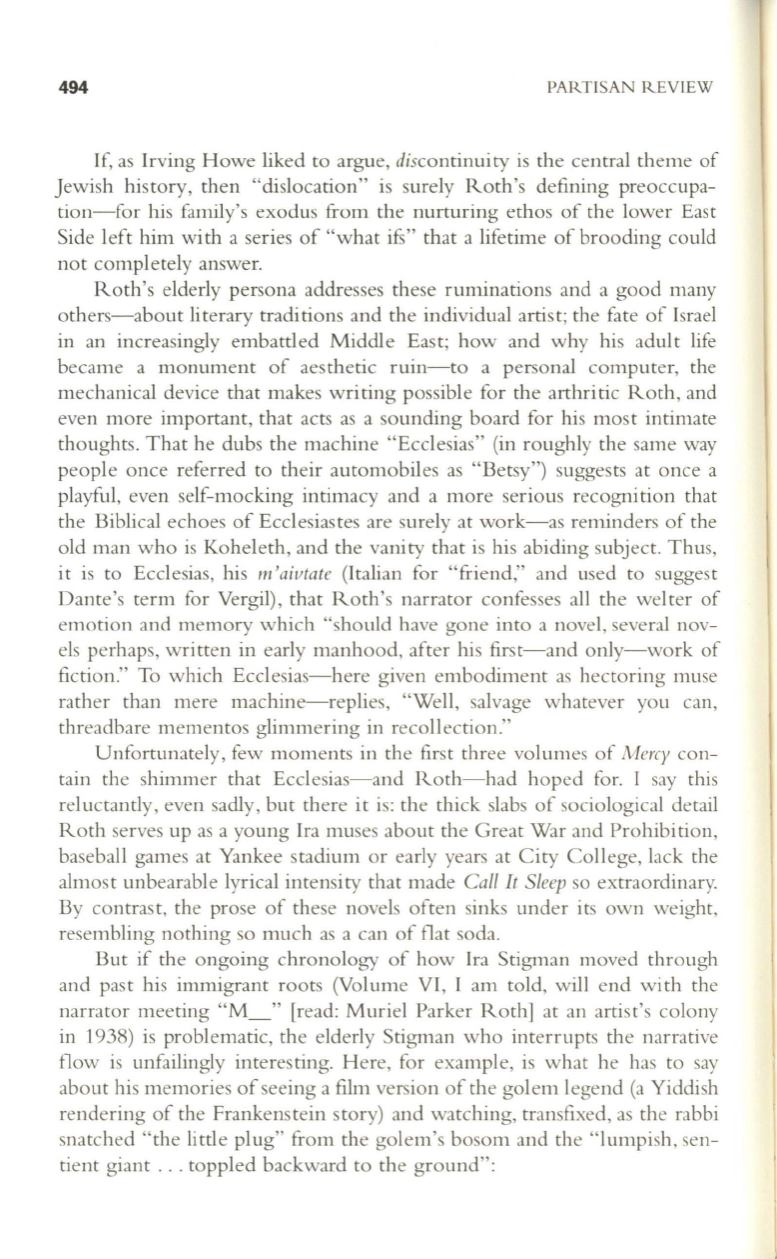
494
PARTISAN REVIEW
If, as Irving Howe liked to argue,
discontinuity
is the central theme of
Jewish history, then "dislocation" is surely Roth's defining preoccupa–
tion-for his family's exodus from tht: nurturing ethos of the lowt:r East
Side left him with a series of "what ifs" that a lifetime of brooding could
not completely answer.
Roth's elderly persona addresses these ruminations and a good many
others-about literary traditions and the individual artist; the fate of Israel
in an increasingly embattled Middle East; how and why his adult life
became a monument of aesthetic ruin-to a personal computer, the
mechanical device that makes writing possible for the arthritic Roth, and
even more important, that acts as a sounding board for his most intimate
thoughts. That he dubs the machine "Ecclesias" (in roughly the same way
people once referred to their automobiles as "Betsy") suggests at once a
playful, even self-mocking intimacy and a more serious recogni tion that
the Biblical echoes of Ecclesiastes are surely at work-as reminders of the
old man who is Koheleth, and the vanity that is his abiding subject. Thus,
it is to Ecclesias, his
m'aivtate
(Italian for "friend," and used to suggest
Dante's term for Vergil), that Roth's narrator confesses all the welter of
emotion and memory which "should have gone into a novel , severa] nov–
els perhaps, written in early manhood, after his first-and only-work of
fiction." To which Ecclesias-here given embodiment as hectoring muse
rather than mere machine-replies, "Well, salvage whatever you can,
threadbare mementos glimmering in recollection."
Unfortunately, few moments in the first three volumes of
Mercy
con–
tain the shimmer that Ecclesias-and Roth-had hoped for. I say this
reluctantly, even sadly, but there it is: the thick slabs of sociological detail
Roth serves up as a young Ira muses about the Great War and Prohibition,
baseball games at Yankee stadium or early years at City College, lack the
almost unbearable lyrical intensity that made
Call It Sleep
so extraordinary.
By contrast, the prose of these novels often sinks under its own weight,
resembling nothing so much as a can of flat soda.
But if the ongoing chronology of how Ira Stigman moved through
and past his immigrant roots (Volume VI, I am told, will end with the
narrator meeting "M_" [read: Muriel Parker Roth] at an artist's colony
in 1938) is problematic, the elderly Stigman who interrupts the narrative
flow is unfailingly interesting. Here, for example, is what he has to say
about his memories of seeing a film version of the golem legend (a Yiddish
rendering of the Frankenstein story) and watching, transfixed, as the rabbi
snatched "the little plug" from the golem's bosom and the "lumpish, sen–
tient giant ... toppled backward to the ground":


